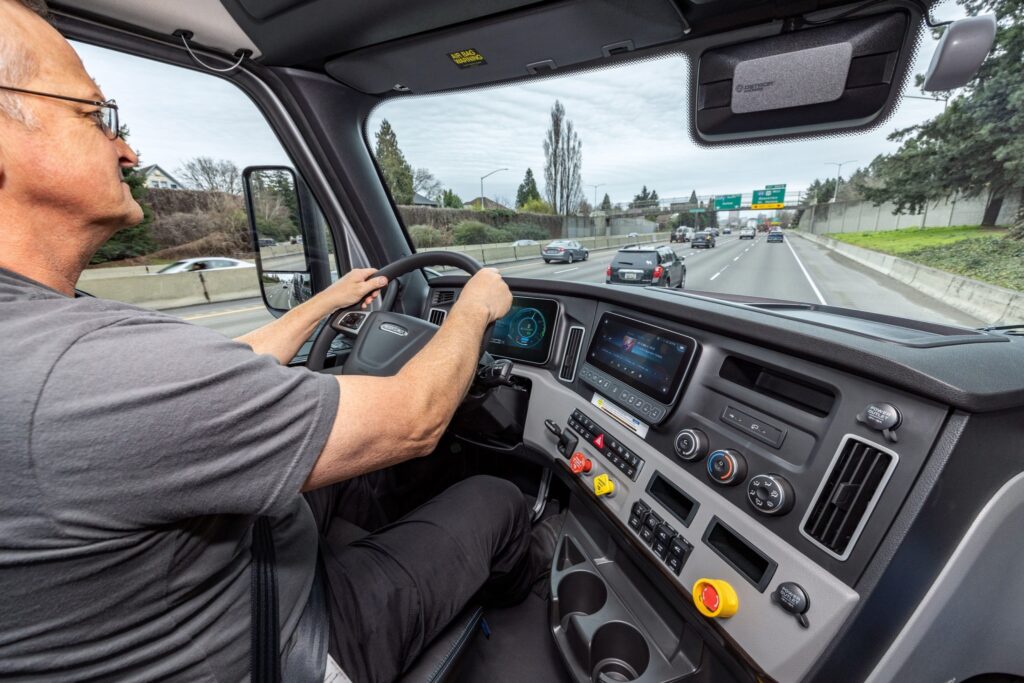Daimler unveils second-gen eCascadia
Freightliner introduced at the ACT Expo show in Long Beach, Calif., an update to its battery-electric eCascadia, with a longer range of up to 230 miles (368 km) in a tandem drive configuration.
The company says the upgraded eCascadia stemmed from extensive testing with customers. There are three battery capacities available – a 438 kWh pack for tandem and single drive configurations, and 291 and 194 kWh packs for single drive applications. Power ratings go from 320-470 hp and an 80% recharge can be achieved in 90 minutes.
“We tested this not for our customers, but with our customers, to ensure we deliver what they need in an electric tractor,” John O’Leary, president and CEO of Daimler Truck North America (DTNA) told trade press editors in a preview of the new eCascadia’s launch.
Rakesh Aneja, vice-president and chief of the eMobility group at DTNA, said improvements in the second-gen eCascadia that came directly from fleet feedback included where on the vehicle the charge port was located, whether to include one or two charge ports, and the ideal length of the charging cable to prevent trip hazards at charging stations.
Meanwhile, emphasis has been put on how the eCascadia will be supported in the field. David Carson, senior vice-president of sales and marketing said the company’s aftermarket group is focused on that.
 Rakesh Aneja (left) and Andreas Juretzka show the second-gen eCascadia for the first time at ACT Expo. (Photo: John G. Smith)
Rakesh Aneja (left) and Andreas Juretzka show the second-gen eCascadia for the first time at ACT Expo. (Photo: John G. Smith)
“We have a dedicated eMobility team within aftermarket, offering training for dealers and customers on high-voltage safety, customer assistance, and working with our parts distribution centers so they have the capabilities to store and handle battery packs, which is not insignificant in terms of scale. They are much larger than what we stock in a parts distribution center today,” Carson said.
Remanufacturing capabilities are also being enhanced to support the eCascadia. And consultation teams are being assembled to walk fleets through the process of developing the entire ecosystem – including charging infrastructure – they’ll need to transition to electric vehicles.
“This is new for all of our customers,” Carson said. “We’re prepared to be able to provide a high level of expertise and consultation.”
Advice will be available, for example, on power requirements, space requirements, where chargers should be installed, and safety parameters. And the aftermarket group is also focused on how batteries will be handled at the end of life.
“What you hear a lot of times, is batteries are going to end up in landfills,” said O’Leary. “I think people are smarter than that these days.”
He said battery pack remanufacturing is an option, as is repurposing batteries for other applications, perhaps stationary. “These are great assets that are able to live on and be reconditioned,” he noted.
The proprietary Detroit ePowertrain will power the second-gen eCascadia, and range improvements came in the form of improved battery chemistry and better integration, said Aneja. At the heart of the system is an e-axle featuring an integrated electric motor, transmission, and related electronics. Two designs include a dual motor option with maximum torque of 23,000 lb.-ft. and 395 hp, and a single motor design with 11,500 lb.-ft./195 hp.
 The new eCascadia was designed to provide a familiar interior with advanced safety systems. (Photo: Daimler Truck North America)
The new eCascadia was designed to provide a familiar interior with advanced safety systems. (Photo: Daimler Truck North America)
To optimize performance of the eCascadia, telematics is available through a specially designed Detroit Connect eServices platform. Daimler has also developed a charger management system (CMS), which is integrated into the Detroit Connect portal. It provides reports on depot utilization, data for grant compliance, and charging management, and is designed to work with the Detroit eFill chargers, though is also compatible with other chargers.
One of the features is an eRange prediction tool which eases range anxiety by calculating range over the course of a proposed trip, taking into account load, weather, traffic and road gradient. Meanwhile, battery health monitoring tracks the battery’s state of health, state of charge, remaining range miles, and charging status. Post-trip reports are offered to analyze how the truck was utilized. All that will be available in the fourth quarter.
The second-gen eCascadia also comes standard with Detroit Assurance active safety features, including active brake assist, active side guard assist, and active lane assist.
At an ACT Expo press conference, hundreds gathered as the second-gen eCascadia was unveiled and rolled soundlessly to the stage. Andreas Juretzka, senior product develop lead – eMobility at DTNA, said “This was four years in the making.”
He said Daimler, based on 1.5 million miles of real-world testing, has coined the phrase “typical range” to describe its 230-mile range, meaning it takes into account actual operating conditions based on extensive fleet experiences.
